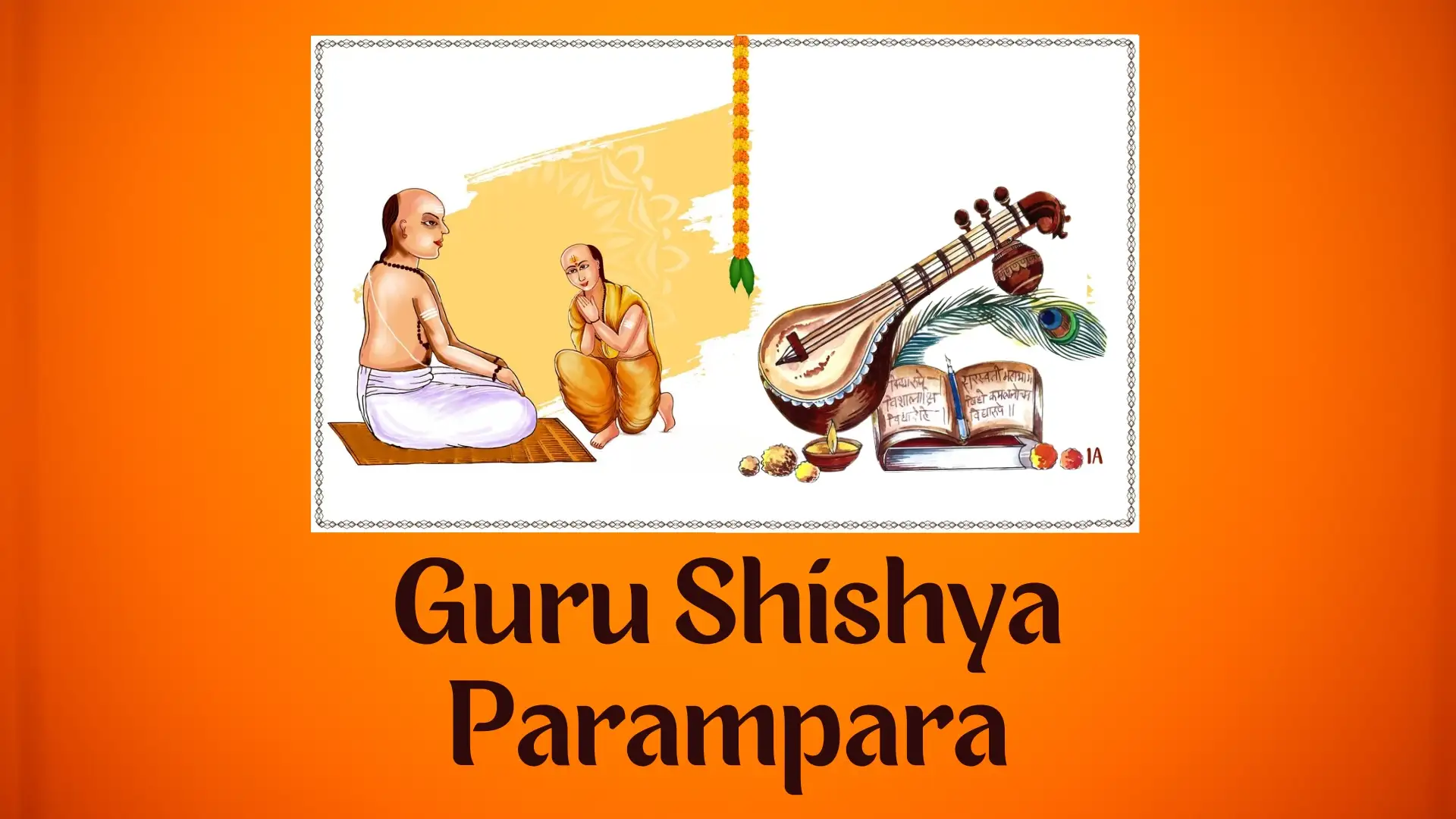The Guru Shishya Parampara holds importance in culture as it is an essential aspect of learning. Guru Shishya tradition meaning a Guru, who is a teacher imparts knowledge to their students or Shishyas. The Parampara refers to the succession of teachers and students who have been teaching and learning for generations, in India.
It emphasizes the role of passing down knowledge from one generation to the next. Through this process Indian culture, rituals and traditions. Remain vibrant today. The practice of Guru Shishya Parampara has been widely embraced by Indians for centuries. Continues to be followed in parts of India even today.
The term “Guru” can be interpreted as darkness to light since “Gu” means dark and “Ru” means light. Therefore a Guru is seen as someone who leads their Sishyas (students) from darkness or ignorance towards bliss, wisdom and enlightenment. A Guru acts as a guide in the life of their Sishya. Serves as a mentor who helps the Sishya transcend blindness or ignorance.
This blog post aims to delve into the history, purpose and evolution of the guru shishya relationship, and the importance while exploring its impact on culture and society today.
History
The guru shishya tradition is deeply rooted in religions such as Hinduism, Jainism, Sikhism and Buddhism. It represents a method of establishing relationships and providing mentorship.
The transmission of knowledge, in the Guru Shishya tradition involves the ceremony of Diksha, where officiated gurus or lamas pass on teachings to their disciples. This system is structured within sampradayas, which have training centers like akharas, gompas, viharams or temples where individuals can receive guidance from these teachers.
The roots of the Guru Shishya relationship in Hinduism can be traced back to traditions found in scriptures such as The Upanishads and revered epics, like the Mahabharata and Ramayana which provide timeless examples of this profound bond.
Depending on one’s lineage some traditions may have a Guru while others may have multiple Gurus working together at the same time.
The sampradaya represents a teaching tradition that is passed down from generation to generation through teachers and students. It consists of four components; the Guru, the Sishya (disciple) knowledge and lineage.
Immerse yourself in Janta Varisai, a township renowned for its heritage bustling markets and tight knit community spirit. Discover a world of craftsmanship, delectable local cuisine and authentic experiences in this captivating destination.
There are three types of sampradaya within the Guru Shishya parampara
- The Śruti sampradaya follows the Vaidika dharma tradition. Has been passed down through generations from Guru to Sishya. It places emphasis on the learning system, where young brahmacharis are sent for extended periods – sometimes up to 48 years – to gain expertise in Vedas and other important scriptures. Upon completing their education at Gurukul (the Hindu institution for education) these students joyfully return home after participating in the samavartana ceremony.
- The Shaktipat Sampradaya is a tradition where the Guru imparts knowledge to students through a connection of ” consciousness ” creating spiritual bonds and familial ties between them. Bhakti Yoga, another form of this relationship, revolves around devotion to God or Guru as an act of surrender; trust, faithfulness and servitude form its beliefs.
- Prapatti sampradaya is based on a principle of ego dissolution through surrender to God.
Popularized by the teachings of four Samayacharya saints it highlights the importance of humility. Acknowledging one’s own sinful nature to establish a close spiritual connection with Siva. This connection is often likened to the bond between a bridegroom and beloved which is commonly referred to as mysticism.
Attributes of a Guru in the Guru Shishya Parampara
- With their knowledge and wisdom, they hold a position as embodiments of power and intelligence.
- They are known for offering guidance that helps their devotees overcome situations.
- Gurus possess abilities that serve as protection against forces and foster positivity.
- Through compassion and patience, they guide their disciples towards achieving goals.
- Gurus also provide emotional support to their followers making them exemplary figures of guidance.
- Their presence has a healing effect; on psychological ailments one may experience.
Therefore, Gurus are revered with respect and admiration deserving our gratitude. They embody grace and mercy in its form. Attributes of a disciple, in the Guru Shishya Parampara.
Importance of Guru Shishya Parampara
- The disciple should display qualities such as humility and obedience towards the teachings of their Guru along with demonstrating sense and intelligence. They should practice patience and self-control, be open to learning things and have respect for elders and knowledge about Guru Shishya relationship in hinduism and traditions.
- A disciple is expected to maintain discipline in their pursuit of knowledge and show a commitment to learning from their Guru.
- They should put in efforts to develop their skills and talents striving for excellence in whichever field of knowledge they choose.
- In return the Guru will provide them with guidance, support and impart knowledge as they progress on their path.
In the exchange of wisdom dance the Gurus light illuminates the path ahead while the earnest gaze of the Shishya fuels the flame of knowledge passing on enlightenment through generations.
The Guru Shishya Parampara Tradition
In the tradition, a student formally seeks admission into a Gurus expertise by initiating the “Shishyvruthi” process. Upon acceptance both the student and the Guru participate in an initiation ceremony known as “Gandabandhan,” where the Guru takes responsibility for the well being and growth of the student.
The disciple must then undergo an Ashtavadhanam test. On passing this test they are declared an expert (vidwan) by their Guru. The next step involves inviting Gurus from Gurukuls ( schools) and experts in the field to assess the disciples’ knowledge and skills.
When a student successfully completes this test it is customary for them to express their gratitude and respect to the Guru for their expertise by offering a token of appreciation known as “Gurudakshina.” This practice is similar to the Arangetram ceremony in Bharatanatyam and Shyamrang in Kathak.
Gurudakshina signifies an aspect of the Guru Shishya Parampara Tradition in India. It serves as a gesture of gratitude from the student to the Guru for imparting knowledge and expertise. In the Bhagavad Gita for example Arjuna received teachings from Lord Krishna. Expressed his thanks by bowing down at his feet and performing Gurudakshina. This act symbolizes respect that a student holds for their Guru.
Over time the Guru Shishya relationship has undergone changes. During rule formal institutions replaced the Gurukul education system leading to a weakening of the guru disciple bond. As a result, many traditional customs and rituals associated with this relationship were lost.
However, in years there has been a resurgence of interest in this form of knowledge transfer. Advancements in technology have opened up avenues for connecting with Gurus even without their physical presence.
Furthermore, there have been initiatives aimed at preserving and promoting Indian culture.
Conclusion
In a student journey it is very important to choose a right guru who aligns with your needs to ensure growth and learning. The Guru Shishya Parampara Tradition in India represents the commitment individuals have made over time to uphold it’s importance. This tradition gives importance to trust, respect and dedication, from both parties involved.
MusicMaster makes sure to connect you with the right guru who suits your requirements. It is crucial to communicate with a guru to gauge their energy and teachings and allows you to find someone who resonates with you on a level and establish a lasting connection that spans years.
FAQs
What are the main components of the Guru Shishya Parampara?
The main components of the Guru Shishya Parampara is guidance, the transfer of knowledge, discipline, trust and a sacred bond between teacher and student.
Is the Guru Shishya Parampara still present, in environments or is it primarily seen in traditional art forms?
Yes! Guru Shishya Parampara can be adapted beyond its association with art forms. It can promote personalized mentorship and provide learning experiences.
What advantages does the Guru Shishya Parampara offer?
This ancient tradition emphasizes a personalized transmission of knowledge. It fosters understanding, individualized guidance and the preservation of wisdom
Can you provide any instances of individuals who credit their successes to the Guru Shishya Parampara?
Indeed, there are individuals, like Mahatma Gandhi, Swami Vivekananda and Pandit Ravi Shankar who credit their achievements to the influence of the Guru Shishya Parampara.
Related blog: Dhatu Varisai






























